Australian Army
The Australian Army is Australia's military land force. Formed in 1901 through the amalgamation of the Australian colonial forces following federation, it is part of the Australian Defence Force (ADF) along with the Royal Australian Navy and the Royal Australian Air Force. While the Chief of the Defence Force (CDF) commands the ADF, the Army is commanded by the Chief of Army (CA). The CA is therefore subordinate to the CDF, but is also directly responsible to the Minister for Defence.[3] Although Australian soldiers have been involved in a number of minor and major conflicts throughout Australia's history, only during the Second World War has Australian territory come under direct attack.
| Australian Army | |
|---|---|
 | |
| Founded | 1 March 1901 |
| Country | Australia |
| Allegiance | Queen Elizabeth II |
| Type | Army |
| Size | 29,511 (Regular) 18,738 (Active Reserve)[1] |
| Part of | Australian Defence Force |
| Engagements |
|
| Website | www |
| Commanders | |
| Commander-in-chief | General David Hurley (As Governor-General of Australia) |
| Chief of the Defence Force | General Angus Campbell |
| Chief of Army | Lieutenant General Rick Burr |
| Deputy Chief of Army | Major General Anthony Rawlins |
| Commander Forces Command | Major General Chris Field |
| Insignia | |
| Australian Army flag | .svg.png) |
| Roundel (aviation) |  |
| Roundel (armoured vehicles) |  |
History
Formed in March 1901, with the amalgamation of the six separate colonial military forces, the history of the Australian Army can be divided into two periods:
- 1901–47, when limits were set on the size of the regular Army, the vast majority of peacetime soldiers were in reserve units of the Citizens Military Force (also known as the CMF or Militia), and expeditionary forces (the First and Second Australian Imperial Forces) were formed to serve overseas,[4][5] and
- Post-1947, when a standing peacetime regular infantry force was formed and the CMF (known as the Army Reserve after 1980) began to decline in importance.[6][5]
.jpg)
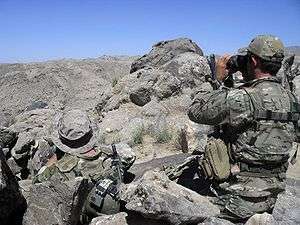
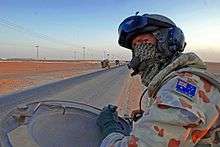
During its history the Australian Army has fought in a number of major wars, including: Second Boer War (1899–1902), First World War (1914–18), the Second World War (1939–45), Korean War (1950–53), Malayan Emergency (1950–60), Indonesia-Malaysia Confrontation (1962–66), Vietnam War (1962–73),[7] and more recently in Afghanistan (2001 – present) and Iraq (2003–09).[8] Since 1947 the Australian Army has also been involved in many peacekeeping operations, usually under the auspices of the United Nations, however the non-United Nations sponsored Multinational Force and Observers in the Sinai is a notable exception. Australia's largest peacekeeping deployment began in 1999 in East Timor, while other ongoing operations include peacekeeping on Bougainville, in the Sinai, and in the Solomon Islands. Humanitarian relief after 2004 Indian Ocean earthquake in Aceh Province, Indonesia, Operation Sumatra Assist, ended on 24 March 2005.[9]
Since April 2015, the Army has deployed a 300-strong element to Iraq, designated as Task Group Taji, as part of Operation Okra. In support of a capacity building mission, Task Group Taji's main role has been to provide training to Iraqi forces, during which Australian troops have served alongside troops from New Zealand.[10]
Current organisation

The 1st Division comprises a deployable headquarters, while 2nd Division under the command of Forces Command is the main home-defence formation, containing Army Reserve units. 2nd Division's headquarters only performs administrative functions. The Australian Army has not deployed a divisional-sized formation since 1945 and does not expect to do so in the future.[11]
1st Division
1st Division carries out high-level training activities and deploys to command large-scale ground operations. It has few combat units permanently assigned to it, although it does currently command the 2nd Battalion, Royal Australian Regiment as part of Australia's amphibious task group.[12]
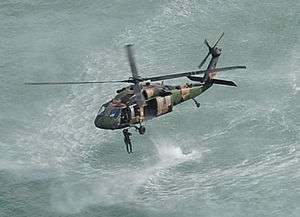
Forces Command
Forces Command controls for administrative purposes all non-special-forces assets of the Australian Army. It is neither an operational nor a deployable command.
- 1 Brigade – Multi-role Combat Brigade based in Darwin and Adelaide.
- 3 Brigade – Multi-role Combat Brigade based in Townsville.
- 6 Brigade (CS&ISTAR) – Mixed brigade based in Sydney.
- 7 Brigade – Multi-role Combat Brigade based in Brisbane.
- 16 Aviation Brigade – Army Aviation brigade based in Enoggera, Brisbane.
- 17 Sustainment Brigade – Logistic brigade based in Sydney.
- 2nd Division administers the reserve forces from its headquarters located in Sydney.
- 4 Brigade – based in Victoria.
- 5 Brigade – based in New South Wales.
- 8 Brigade – training brigade with units around Australia
- 9 Brigade – based in South Australia and Tasmania.
- 11 Brigade – based in Queensland.
- 13 Brigade – based in Western Australia.
Additionally, Forces Command includes the following training establishments:
- Army Recruit Training Centre at Kapooka, NSW;
- Royal Military College, Duntroon in the ACT;
- Combined Arms Training Centre at Puckapunyal, Vic;
- Army Logistic Training Centre at Bonegilla, Vic and Bandiana, Vic; and
- Army Aviation Training Centre at Oakey, QLD.[13]

Special Forces
Special Operations Command comprises a command formation of equal status to the other commands in the ADF. It includes all of Army's special forces assets.
Planned restructuring
Under a restructuring program known as Plan Beersheba announced in late 2011, the 1st, 3rd and 7th Brigades will be re-formed as combined-arms multi-role manoeuvre brigades with the 2nd Battalion, Royal Australian Regiment (part of the 3rd Brigade) forming the core of a future amphibious force.[14] The force will be known as the Amphibious Ready Element and will be embarked on the Navy's new Canberra-class amphibious assault ships.
Colours, standards and guidons
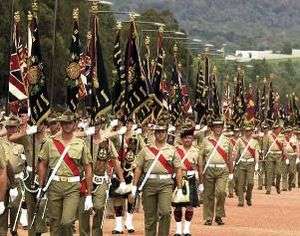
Infantry, and some other combat units of the Australian Army carry flags called the Queen's Colour and the Regimental Colour, known as "the Colours".[15] Armoured units carry Standards and Guidons – flags smaller than Colours and traditionally carried by Cavalry, Lancer, Light Horse and Mounted Infantry units. The 1st Armoured Regiment is the only unit in the Australian Army to carry a Standard, in the tradition of heavy armoured units. Artillery units' guns are considered to be their Colours, and on parade are provided with the same respect.[16] Non-combat units (combat service support corps) do not have Colours, as Colours are battle flags and so are only available to combat units. As a substitute, many have Standards or Banners.[17] Units awarded battle honours have them emblazoned on their Colours, Standards and Guidons. They are a link to the unit's past and a memorial to the fallen. Artillery do not have Battle Honours – their single Honour is "Ubique" which means "Everywhere" – although they can receive Honour Titles.[18]
The Army is the guardian of the National Flag and as such, unlike the Royal Australian Air Force, does not have a flag or Colours. The Army, instead, has a banner, known as the Army Banner. To commemorate the centenary of the Army, the Governor General Sir William Deane, presented the Army with a new Banner at a parade in front of the Australian War Memorial on 10 March 2001. The Banner was presented to the Regimental Sergeant Major of the Army (RSM-A), Warrant Officer Peter Rosemond.
The Army Banner bears the Australian Coat of Arms on the obverse, with the dates "1901–2001" in gold in the upper hoist. The reverse bears the "rising sun" badge of the Australian Army, flanked by seven campaign honours on small gold-edged scrolls: South Africa, World War I, World War II, Korea, Malaya-Borneo, South Vietnam, and Peacekeeping. The banner is trimmed with gold fringe, has gold and crimson cords and tassels, and is mounted on a pike with the usual British royal crest finial.[19]
Personnel
Strength
As of June 2018 the Army had a strength of 47,338 personnel: 29,994 permanent (regular) and 17,346 active reservists (part-time).[20] In addition, the Standby Reserve has another 12,496 members (as of 2009).[21] As of 2018, women make up 14.3% of the Army – well on track to reach its current goal of 15% by 2023. The number of women in the Australian military has increased dramatically since 2011 (10%), with the announcement that women would be allowed to serve in frontline combat roles by 2016.[22]
Rank and insignia
The ranks of the Australian Army are based on the ranks of the British Army, and carry mostly the same actual insignia. For officers the ranks are identical except for the shoulder title "Australia". The Non-Commissioned Officer insignia are the same up until Warrant Officer, where they are stylised for Australia (for example, using the Australian, rather than the British coat of arms). The ranks of the Australian Army are as follows:
- Private (PTE) – OR-2
- Private Proficient (PTE(P)) Also used within the Private equivalent ranks – OR-3
- Lance Corporal or Lance Bombardier (LCPL or LBDR) – OR-4
- Corporal or Bombardier (CPL or BDR) – OR-5
- Sergeant (SGT) – OR-6
- Staff Sergeant (SSGT) – OR-7 (SSGT is being phased out of the Australian Army)
- Warrant Officer Class Two (WO2) – OR-8
- Warrant Officer Class One (WO1) – OR-9
- Regimental Sergeant Major of the Army (RSM-A) – OR-9 (This is an appointment rather than a rank)
- Second Lieutenant (2LT) – OF-1
- Lieutenant (LT) – OF-2
- Captain (CAPT) – OF-3
- Major (MAJ) – OF-4
- Lieutenant Colonel (LTCOL) – OF-5
- Colonel (COL) – OF-6
- Brigadier (BRIG) – OF-7. Like the United Kingdom, prior to 1922 Australia used the rank Brigadier General
- Major General (MAJGEN) – OF-8
- Lieutenant General (LTGEN) – OF-9
- General (GEN) – OF-10
- Field Marshal (FM) – OF-11. This rank is generally reserved for wartime and ceremonial purposes; there are no regular appointments to the rank. Sir Thomas Blamey is the only Australian-born officer promoted to the rank. Prince Philip, Duke of Edinburgh, is currently the only living holder of the rank of Field Marshal in the Australian Army. The Duke, however, does not have any active role in the Australian command structure.
Equipment

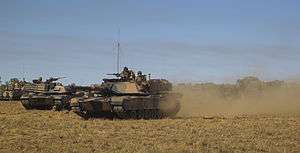
| Small arms | F88 Austeyr (service rifle), F89 Minimi (support weapon), Browning Hi-Power (sidearm), MAG-58 (general purpose machine gun), SR-25 designated marksman rifle, SR-98 (sniper rifle), Mk48 Maximi, AW50F |
| Special forces | M4 carbine, Heckler & Koch USP, SR-25, F89 Minimi, MP5, SR-98, Mk48, HK416, HK417, Blaser R93 Tactical, Barrett M82, Mk14 EBR |
| Main battle tanks | 59 M1A1 Abrams |
| Armoured recovery vehicle | 13 M88A2 Hercules armoured recovery vehicles[23][24] |
| Reconnaissance vehicles | 257 ASLAV. To be replaced, beginning in 2019, with 211 Boxer (armoured fighting vehicle) |
| Armoured Personnel Carriers | 431 M113 Armored Vehicles upgraded to M113AS3/4 standard (around 100 of these will be placed in reserve) |
| Infantry Mobility Vehicles | 1,052 Bushmaster PMVs;[25][26][27] 31 HMT Extenda Mk1 Nary vehicles and 89 HMT Extenda Mk2 on order |
| Light Utility Vehicles | 2,268 G-Wagon 4 × 4 and 6x6, 1,500 Land Rover FFR and GS, 1,295 Unimog 1700L |
| Artillery | 112 L118/L119 105 mm Hamel Guns (In reserve), 36 M198 155 mm Howitzer (In reserve), 54 M777A2 155 mm Howitzer, 36 RBS-70 surface-to-air missile systems. |
| Radar | AN/TPQ-36 Firefinder radar, AMSTAR Ground Surveillance RADAR, AN/TPQ-48 Lightweight Counter Mortar Radar, GIRAFFE FOC, Portable Search and Target Acquisition Radar – Extended Range. |
| Unmanned Aerial Vehicles | RQ-7B Shadow 200, Wasp AE ,and PD-100 Black Hornet[28][29] |
Current aircraft
| Aircraft | Type | Versions | Number in service[30] | Notes | ||
|---|---|---|---|---|---|---|
| Helicopters | ||||||
| Boeing CH-47 Chinook | Transport helicopter |
CH-47F |
10[31] |
One CH-47D lost in Afghanistan on 30 May 2011. From an initial fleet of six; two additional CH-47Ds were ordered in December 2011 as attrition replacement and to boost heavy lift capabilities until the delivery of seven CH-47Fs, which will replace the CH-47Ds. All seven Chinooks were delivered in August 2015. The US State Department has approved the possible sale of three more CH-47F aircraft as of December 2015.[32] The 2016 Defence White Paper confirmed the order of three CH-47F aircraft.[33] | ||
| Eurocopter EC135 | Training helicopter | EC135T2+ | 15 | Delivery completed 22 November 2016 [34][35] | ||
| Eurocopter Tiger | Attack helicopter | Tiger ARH | 22 | Delivery completed early July 2011. Achieved Final Operational Capability on 14 April 2016.[36] | ||
| UH-60 Black Hawk | Utility helicopter | S-70A-9 | 20 | Replaced by the MRH 90 in 2017 for utility and transport roles. 20 to be kept in operational service for special forces until the end of 2021 due to issues with MRH 90.[37][38] | ||
| NHIndustries MRH-90 Taipan | Utility helicopter | TTH: Tactical Transport Helicopter | 47 | 47 in service (including 6 for Royal Australian Navy) | ||
 Australian Army Sikorsky S-70 Black Hawk
Australian Army Sikorsky S-70 Black Hawk_NHI_MRH-90_arriving_at_Wagga_Wagga_Airport.jpg) An Australian Army MRH-90
An Australian Army MRH-90_Eurocopter_Tiger_ARH_display_at_the_2015_Australian_International_Airshow.jpg) Australian Army Tiger ARH
Australian Army Tiger ARH
Bases
The Army's operational headquarters, Forces Command, is located at Victoria Barracks in Sydney.[39] The Australian Army's three regular brigades are based at Robertson Barracks near Darwin,[40] Lavarack Barracks in Townsville, and Gallipoli Barracks in Brisbane.[41] The Deployable Joint Force Headquarters is also located at Gallipoli Barracks.[42]
Other important Army bases include the Army Aviation Centre near Oakey, Queensland, Holsworthy Barracks near Sydney, Lone Pine Barracks in Singleton, New South Wales and Woodside Barracks near Adelaide, South Australia.[43] The SASR is based at Campbell Barracks Swanbourne, a suburb of Perth, Western Australia.[44]
Puckapunyal, north of Melbourne, houses the Australian Army's Combined Arms Training Centre,[45] Land Warfare Development Centre, and three of the five principal Combat Arms schools. Further barracks include Steele Barracks in Sydney, Keswick Barracks in Adelaide, and Irwin Barracks at Karrakatta in Perth. Dozens of Australian Army Reserve depots are located across Australia.
Australian Army Journal
Since June 1948, the Australian Army has published its own journal titled the Australian Army Journal. The journal's first editor was Colonel Eustace Keogh, and initially, it was intended to assume the role that the Army Training Memoranda had filled during the Second World War, although its focus, purpose, and format has shifted over time.[46] Covering a broad range of topics including essays, book reviews and editorials, with submissions from serving members as well as professional authors, the journal's stated goal is to provide "...the primary forum for Army's professional discourse... [and to facilitate]... debate within the Australian Army ...[and raise] ...the quality and intellectual rigor of that debate by adhering to a strict and demanding standard of quality".[47] In 1976, the journal was placed on hiatus as the Defence Force Journal began publication;[46] however, publishing of the Australian Army Journal began again in 1999 and since then the journal has been published largely on a quarterly basis, with only minimal interruptions.[48]
Future procurement
This list includes equipment currently on order or a requirement which has been identified:
- A replacement for the Tiger ARH helicopter was identified in the 2016 Defence White Paper. The Army is set to retire the helicopter earlier than expected after encountering numerous issues with sustainment and serviceability rates. While the Tigers were initially supposed to get a $1–2 billion mid-life upgrade, a new type of helicopter—either manned, unmanned or a combination of both—is set to enter service from the mid 2020s.[49]
- A new deployable short-range ground-based air defence missile system is slated to replace the RBS-70 MANPADS by the early 2020s.[50]
- A new medium-range air defence system is also to be acquired in the late 2020s. The new system will help defend deployed airfields, command centres and other valuable assets from enemy air attack.[50] The Army has lacked a medium-range air defence system capability since the Rapier's retirement in 2005.[51]
- Land-based anti-ship missiles were outlined as a new requirement in the 2016 Defence White Paper to defend deployed forces as well as offshore assets such as oil and natural gas platforms.[50]
- The Australian Government committed to improving the systems that individual soldiers use. Items outlined in the DWP include "weapons and targeting equipment, digital communications systems, body armour and self protection equipment (including for chemical, biological and radiological threats), and night fighting equipment."[50]
- 1,100 Hawkei protected mobility vehicles are currently being procured at a cost of around $1.3 billion.[52]
- The Bushmaster PMV is to be replaced beginning in 2025 by a new platform.[50]
- Land 400 phase 2 replacement program is set to replace the existing 257 ASLAVs with 211 Boxers.[53]
- Land 400 phase 3 replacement program is set to replace 431 M113AS3/4 APCs.
- To complement current artillery, a new class of long-range rocket artillery is to be introduced in the mid 2020s. The new system, yet to be named, will be able to provide fire support for troops at three hundred kilometres.[50]
- A riverine patrol capability is to be re-established in 2022. The capability will be established around a fleet of small, lightly armed patrol vessels to allow access to a range of different environments.[50]
- The Army has outlined a need for enhanced intelligence, surveillance and reconnaissance capability. With this, they plan to acquire a fleet of armed, medium-range unmanned aerial vehicles along with regular capability updates. They will provide enhanced firepower and ISR as well as a counter-terrorism ability overseas. They will also assist in humanitarian and relief missions.[50]
See also
- Australian Defence Force ranks and insignia
- List of Australian military memorials
- Conscription in Australia
- Australian military slang
- Battle and theatre honours of the Australian Army
- Uniforms of the Australian Army
Citations
- Commonwealth of Australia (2019). "Department of Defence Annual Report 2018-19" (PDF). Department of Defence.
- https://www.aspistrategist.org.au/a-century-on-remembering-the-australians-who-fought-in-the-russian-civil-war/
- "Defence Act (1903) – SECT 9 Command of Defence Force and arms of Defence Force". Australasian Legal Information Institute. Retrieved 19 October 2010.
- Grey 2008, pp. 88 & 147.
- Odgers 1988, p. 5.
- Grey 2008, pp. 200–201.
- Odgers 1988.
- Grey 2008, pp. 284–285.
- "Australian War Memorial Official History of Peacekeeping, Humanitarian and Post-Cold War Operations". Retrieved 4 April 2009.
- Department of Defence (15 April 2015). "Troops to deploy to Iraq" (Press release). Archived from the original on 3 April 2016. Retrieved 3 August 2019.
- Horner 2001, p. 195.
- Doran, Mark. "Amphibious Display". Army. Department of Defence. p. 12.
- "Forces Command". Australian Army. Archived from the original on 7 September 2013. Retrieved 11 September 2013.
- Minister for Defence, Minister for Defence Materiel and Parliamentary Secretary for Defence (12 December 2011). "New structure and capability for Army" (Press release). Archived from the original on 2 August 2014.
- Jobson 2009, p. 53.
- Jobson 2009, pp. 55–56.
- "National Flags, Military Flags, & Queens and Regimental Colours". Digger History. Archived from the original on 5 April 2007. Retrieved 3 April 2007.
- Jobson 2009, p. 58.
- "Army Flags (Australia)". Flags of the World. Archived from the original on 3 April 2007. Retrieved 3 April 2007.
- Commonwealth of Australia (2019). "Department of Defence Annual Report 2017-18" (PDF). Department of Defence. Retrieved 17 May 2019.
- Australian National Audit Office (2009). Army Reserve Forces (PDF). Audit Report No. 31 2008–09. Canberra: Australian National Audit Office. ISBN 0-642-81063-X. Archived from the original (PDF) on 15 May 2009.
- Commonwealth of Australia (2019). "Women in the ADF Report 2017-18: A Supplement To The Defence Annual Report 201718". Department of Defence. Retrieved 17 May 2019.
- Australian Army. "M1 Abrams Tank – Australian Army". www.army.gov.au. Archived from the original on 12 October 2016. Retrieved 1 February 2016.
- "Army officially accepts new armoured vehicles". defenceconnect.com.au. Retrieved 21 April 2017.
- "Contract Signed for Additional Bushmasters" (Press release). The Hon. Joel Fitzgibbon MP, Minister for Defence. 29 October 2008. Retrieved 29 October 2008.
- "More vehicles on the way". Army News. Canberra: Australian Department of Defence. 26 May 2011. p. 16.
- "Australian Army orders additional Bushmasters from Thales". Retrieved 2 November 2012.
- "Unmanned Aerial Vehicles | Army.gov.au". www.army.gov.au. Retrieved 5 June 2020.
- "Australian Army tests out drones for surveillance". iTnews. Retrieved 5 June 2020.
- "World Air Forces 2016 report". flightglobal.com. Retrieved 10 December 2015.
- "Three more CH-47F helicopters delivered ahead of schedule in FMS deal". Australian Aviation. 26 June 2016. Retrieved 1 August 2016.
- "Australia set to acquire three more CH-47F Chinooks". Australian Aviation. Retrieved 2 January 2016.
- 2016 Defence White Paper (PDF). Australia: Commonwealth of Australia. 2016. p. 20. ISBN 978-0-9941680-5-4.
- "Minister for Defence – New training system for ADF helicopter crews". Media Release. Minister for Defence. 23 October 2014. Archived from the original on 25 August 2016. Retrieved 1 August 2016.
- McMaugh, Dallas (9 April 2016). "Future ADF training helicopter arrives at HMAS Albatross". Royal Australian Navy. Retrieved 1 August 2016.
- Beurich, Cpl Sebastian (28 July 2016). "A story of innovation and commitment" (PDF). Army: The Soldiers' Newspaper (1378 ed). Retrieved 31 July 2016.
- Kerr, Julian (2 December 2015). "Australian Army to extend Black Hawk service lives for special forces use". Jane 's Defence Weekly (53.4). Retrieved 30 July 2016.
- "S-70A-9 Black Hawk Weapons". Defence Materiel Organisation. Department of Defence. Retrieved 8 November 2014.
- "Forces Command". Our people. Australian Army. Retrieved 3 August 2019.
- "1st Brigade". Our people. Australian Army. Retrieved 3 August 2019.
- "7th Brigade". Our people. Australian Army. Retrieved 3 August 2019.
- "1st Division". Our people. Australian Army. Archived from the original on 14 September 2018. Retrieved 3 August 2019.
- "Defence Bases". Department of Defence. Retrieved 9 June 2020.
- Lee 2007, p. 30.
- "Australian Army skills at Arms Meet 2018". Media Releases. Department of Defence. 4 May 2018. Retrieved 7 June 2018.
- Dennis 1995, p. 60.
- "Australian Army Journal". Publications. Australian Army. Retrieved 3 September 2015.
- "Past editions: Australian Army Journal". Publications. Australian Army. Archived from the original on 12 March 2015. Retrieved 3 September 2015.
- ""Troubled" Tiger set for early retirement, new light helicopter for Special Forces on the way". Australian Aviation. australianaviation.com.au. 26 February 2016. Retrieved 28 February 2016.
- 2016 Defence White Paper. Australia: Commonwealth of Australia. 2016. pp. 94–98. ISBN 978-0-9941680-5-4.
- "16 Air Defence Regiment History". Australian Air Defence Artillery Association. Australian Air Defence Artillery Association. Archived from the original on 26 February 2016. Retrieved 28 February 2016.
- "White paper full of praise for Hawkei". Bendigo Advertiser. Bendigo Advertiser. 25 February 2016. Retrieved 28 February 2016.
- "Land Combat Vehicle System". Department of Defence. Retrieved 3 August 2019.
References
- Dennis, Peter; Grey, Jeffrey; Morris, Ewan; Prior, Robin (1995). The Oxford Companion to Australian Military History. Melbourne: Oxford University Press. ISBN 0-19-553227-9.
- Grey, Jeffrey (2008). A Military History of Australia (3rd ed.). Melbourne, Victoria: Cambridge University Press. ISBN 978-0-521-69791-0.CS1 maint: ref=harv (link)
- Horner, David (2001). Making the Australian Defence Force. Melbourne, Victoria: Oxford University Press. ISBN 0-19-554117-0.CS1 maint: ref=harv (link)
- Jobson, Christopher (2009). Looking Forward, Looking Back: Customs and Traditions of the Australian Army. Wavell Heights, Queensland: Big Sky Publishing. ISBN 978-0-9803251-6-4.CS1 maint: ref=harv (link)
- Lee, Sandra (2007). 18 Hours: The True Story of an SAS War Hero. Pymble, New South Wales: HarperCollins. ISBN 978-0-73228-246-2.CS1 maint: ref=harv (link)
- Odgers, George (1988). Army Australia: An Illustrated History. Frenchs Forest, New South Wales: Child & Associates. ISBN 0-86777-061-9.CS1 maint: ref=harv (link)
Further reading
- Australian Department of Defence (2009). Defence Annual Report 2008–09. Canberra, Australian Capital Territory: Defence Publishing Service. ISBN 978-0-642-29714-3.
- Grey, Jeffrey (2001). The Australian Army. South Melbourne, Victoria: Oxford University Press. ISBN 978-0-19554-114-4.
- Palazzo, Albert (2001). The Australian Army: A History of its Organisation 1901–2001. Melbourne, Victoria: Oxford University Press. ISBN 0195515072.
- Terrett, Leslie; Taubert, Stephen (2015). Preserving our Proud Heritage: The Customes and Traditions of the Australian Army. Newport, New South Wales: Big Sky Publishing. ISBN 9781925275544.